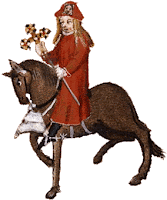During this summer course, we studied the diverse population during the Middle Ages. One group of people that stood out to me was the homosexuals. This group of people was often hidden from Middle Age texts, but in Geoffrey Chaucer’s text, The Canterbury Tales, he incorporates aspects of homosexual characters in some of his tales.
 |
| http://www.luminarium.org /medlit/pardonport.htm |
In the Prologue to the Pardoner’s Tale, the Pardoner actually makes the Host kiss him, “And ye, sire Hoost, that been to me so deere, I prey yow that ye kisse the Pardoner” (Chaucer, 277). The Pardoner asks another man, the Host, to kiss him because he was upset that the Host was making fun of him. Instead of refusing to kiss him, the Host agrees and follows through.
Not only do we see physical actions between the Pardoner and other men, but we also are given descriptions of him that show his feminine side. Monica McAlpine looks further into the specific word choice Chaucer used in describing the Pardoner, “The description of the Pardoner’s hair — its length and fineness suggesting effeminacy, eunuchry, and hermaphroditism and his grooming of its suggesting effeminacy; the Pardoner’s concern with fashion, implying effeminacy: the references to goats and hairs, suggesting hermaphroditism; the high voice, connoting effeminacy and eunuchry” (McAlpine, 13). McAlpine finds several reasons why one may consider the Pardoner to be a homosexual. She looks at his hair, his voice, his love for fashion, and beardlessness to draw a conclusion about his sexuality. One aspect that was very interesting was that the Pardoner did not have a beard. During the Middle Ages, a beard showed one’s masculinity. So, by the Pardoner not having a beard, he was expressing his feminine side.
 |
| https://uncrcow.tumblr.com /post/179114171134/ how-was-homosexuality- treated-in-medieval-times |
Studying Middle Aged text can be very difficult for our modern society to understand. McAlpine also discusses another very important aspect which is that our interpretation of Middle-Aged texts may be very different. This is very important to think about because when we read Chaucer’s text and hear things like how the Pardoner does not have a beard, it might not strike us that he was showing signs of feminism. But, if we were from the Middle Ages, it would be clearer to us that he was more feminine.
In an article written by Richard Zeikowitz that engages in the homosexual aspects of the Pardoner’s Tale. One point that he states is the importance of incorporating historical texts that include homosexuality, “Queering in the Middle Ages works hand in hand with queering the present- a process that may pave the way for a society that genuinely engages difference” (Zeikowitz, 79). Zeikowitz points out how many teachers only show their students heterosexual texts. Introducing homosexuality into historical texts can lead to understanding and reacting positively towards homosexuals. Zeikowitz includes an assignment that teachers can do with their students while reading The Pardoner’s Tale which is to have students think about how the Pardoner would fit into today’s society and which of his characteristics would be against the norm. Linking homosexual historical texts to our culture today can give students a better understanding and development of homosexuality.
Overall, this theme of homosexuality in The Canterbury Tales allows readers to see that there were homosexuals during this time period. Many of them were hidden from the historical texts that we see today, but they were present, especially in Chaucer’s text. It is important to pick up on the words and actions Chaucer had included in his text to really understand the Pardoner’s sexuality. Engaging in historical works that include homosexuality is important to further our views on people who are not with the norm.
No comments:
Post a Comment